







































JORDAN AT A GLANCE
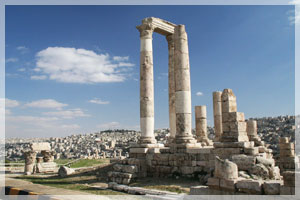 The Hashemite Kingdom of Jordan, which once captivated ancient travellers, continues to enthral a whole new generation as a modern, vibrant nation.
The Hashemite Kingdom of Jordan, which once captivated ancient travellers, continues to enthral a whole new generation as a modern, vibrant nation.
From the haunting, primeval starkness of Wadi Rum, to the teeming centre of urban Amman, from the majestic ruins of bygone civilizations to the timeless splendour of the Dead Sea, Jordan is unveiled as a unique destination offering breathtaking and mysterious sights, high standard accommodations, exquisite cuisine and countless activities that can provide visitors with inspiration, motivation, and rejuvenation.
Marvelling at herds of gazelles and Oryx and migrating birds, camping amidst the grandeur of Wadi Rum or Dana Reserve, trekking the ancient caravan trails from the highlands of Moab and Edom, hiking the wooded hills of biblical Gilead, or experiencing the unique, cleansing mud baths of the Dead Sea are just a few examples of the treasures awaiting visitors to this unique kingdom.
The new stream of luxury hotels emerging in Amman, Petra, Aqaba and the Dead Sea is just adding quality to a refined product that is distinct, accessible and friendly; a product that is home to a new display of modern meeting facilities and unique venues for incentive travel as well.
Whether it is a conference for 5000 people, a lavish dinner in the peerless desert of Wadi Rum, a barbecue at the shores of the Dead Sea , or a reception atop a medieval castle overlooking the Jordan Valley, the amicable and competent people of Jordan will ensure a once in a lifetime memorable experience.
Jordan is a modern country with an ancient culture, a land of which visitors can walk through the valleys, hills and plains whose names have become part of human history by virtue of the simple deeds and profound messages of prophets who walked the land and crossed its rivers during their lives.
Many of the sites where they are said to have performed miracles or reached out to ordinary people have been identified, excavated and protected, and are now more easily accessible to visitors.
Jordan is an ideal destination for those seeking cultural knowledge and spiritual enrichment. Jordan values its ethnically and religiously diverse population, consequently providing for the cultural rights of all its citizens. This spirit of tolerance and appreciation is one of the central elements contributing to the stable and peaceful cultural climate flourishing within Jordan. More than 92% of Jordanians are Sunni Muslims and approximately 6% are Christians. The majority of Christians belong to the Greek Orthodox Church, but there are also Greek Catholics, a small Roman Catholic community, Syrian Orthodox, Coptic Orthodox, Armenian Orthodox, and a few Protestant denominations. Several small Shi'a and Druze populations can also be found in Jordan.
As Jordan is an Islamic state, one may explore the principles of Islam through direct interaction with the people of this monotheistic religion. As the capstone of a long tradition beginning with Judaism and Christianity, Muslims believe that Islam completes the revelation of God's message to humankind. Islam – which in Arabic means "submission" - is an assertion of the unity, completeness, and sovereignty of God. Muslims believe that God, or Allah as He is known in Arabic, revealed his final message to humankind through the Prophet Muhammad (PBUH) and the Holy Qur'an, which is the divine immutable word of God. Islam focuses heavily on the equality of all humans before the one true God, and therefore it is in many ways a return to the original doctrine of the pure monotheism that characterized the early Judeo-Christian tradition.
Islamic tradition has crystallized five fundamental observances, or "pillars," that are as important as faith in defining Islamic identity and strengthening the common bond that ties all Muslims together. They are Confession of Faith, Daily Prayer (five times per day facing the holy city of Mecca), Fasting during the Islamic holy month of Ramadan, Alms giving, and Pilgrimage to Mecca.

AMMAN
 Amman, the capital of Jordan, is a fascinating city of contrasts – a unique blend of old and new, ideally situated on a hilly area between the desert and the fertile Jordan Valley.
Amman, the capital of Jordan, is a fascinating city of contrasts – a unique blend of old and new, ideally situated on a hilly area between the desert and the fertile Jordan Valley.
In the commercial heart of the city, ultra-modern buildings, hotels, smart restaurants, art galleries and boutiques rub shoulders comfortably with traditional coffee shops and tiny artisans' workshops. Everywhere there is evidence of the city's much older past.
Due to the city's modern-day prosperity and temperate climate, almost half of Jordan's population is concentrated in the Amman area. The residential suburbs consist of mainly tree-lined streets and avenues flanked by elegant, almost uniformly white houses in accordance with a municipal law, which states that all buildings must be faced with local stone.
The downtown area is much older and more traditional with smaller businesses producing and selling everything from fabulous jewellery to everyday household items.
The people of Amman are multi-cultural, multi-denominational, well-educated and extremely hospitable. They welcome visitors and take pride in showing them around their fascinating and vibrant city

PETRA
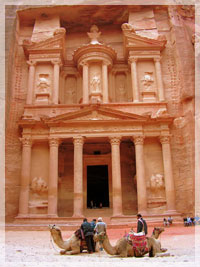 The giant red mountains and vast mausoleums of a departed race have nothing in common with modern civilization, and ask nothing of it except to be appreciated at their true value - as one of the greatest wonders ever wrought by Nature and Man.
The giant red mountains and vast mausoleums of a departed race have nothing in common with modern civilization, and ask nothing of it except to be appreciated at their true value - as one of the greatest wonders ever wrought by Nature and Man.
Although much has been written about Petra, nothing really prepares you for this amazing place. It has to be seen to be believed.
Petra, the world wonder, is without a doubt Jordan's most valuable treasure and greatest tourist attraction. It is a vast, unique city, carved into the sheer rock face by the Nabataeans, an industrious Arab people who settled here more than 2000 years ago, turning it into an important junction for the silk, spice and other trade routes that linked China, India and southern Arabia with Egypt, Syria, Greece and Rome.
Entrance to the city is through the Siq, a narrow gorge, over 1km in length, which is flanked on either side by soaring, 80m high cliffs. Just walking through the Siq is an experience in itself. The colours and formations of the rocks are dazzling. As you reach the end of the Siq you will catch your first glimpse of Al-Khazneh (Treasury).
This is an awe-inspiring experience. A massive façade, 30m wide and 43m high, carved out of the sheer, dusky pink rock-face and dwarfing everything around it. It was carved in the early 1st century as the tomb of an important Nabataean king and represents the engineering genius of these ancient people.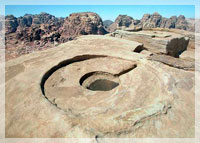 The Treasury is merely the first of the many wonders that make up Petra. You will need at least four or five days to really explore everything here. As you enter the Petra valley you will be overwhelmed by the natural beauty of this place and its outstanding architectural achievements. There are hundreds of elaborate rock-cut tombs with intricate carvings - unlike the houses, which were destroyed mostly by earthquakes, the tombs were carved to last throughout the afterlife and 500 have survived, empty but bewitching as you file past their dark openings. Here also is a massive Nabataean-built, Roman-style theatre, which could seat 3,000 people. There are obelisks, temples, sacrificial altars and colonnaded streets, and high above, overlooking the valley, is the impressive Ad-Deir Monastery – a flight of 800 rock cut steps takes you there.
The Treasury is merely the first of the many wonders that make up Petra. You will need at least four or five days to really explore everything here. As you enter the Petra valley you will be overwhelmed by the natural beauty of this place and its outstanding architectural achievements. There are hundreds of elaborate rock-cut tombs with intricate carvings - unlike the houses, which were destroyed mostly by earthquakes, the tombs were carved to last throughout the afterlife and 500 have survived, empty but bewitching as you file past their dark openings. Here also is a massive Nabataean-built, Roman-style theatre, which could seat 3,000 people. There are obelisks, temples, sacrificial altars and colonnaded streets, and high above, overlooking the valley, is the impressive Ad-Deir Monastery – a flight of 800 rock cut steps takes you there.
Within the site there are also two excellent museums; the Petra Archaeological Museum, and the Petra Nabataean Museum both of which represent finds from excavations in the Petra region and an insight into Petra's colourful past. A 13th century shrine, built by the Mameluk Sultan, Al Nasir Mohammad, to commemorate the death of Aaron, the brother of Moses, can be seen on top of Mount Aaron in the Sharah range.
A 13th century shrine, built by the Mameluk Sultan, Al Nasir Mohammad, to commemorate the death of Aaron, the brother of Moses, can be seen on top of Mount Aaron in the Sharah range.
Inside the site, several artisans from the town of Wadi Musa and a nearby Bedouin settlement have set up small stalls selling local handicrafts, such as pottery and Bedouin jewellery, and bottles of striated multi-coloured sands from the area.
It is not permitted for motorized vehicles to enter the site. But if you don't want to walk, you can hire a horse or a horse-drawn carriage to take you through the one kilometre Siq. For the elderly and/or handicapped, the Visitors' Centre, close to the entrance of the Siq, will issue a special permit (at an extra fee), for the carriage to go inside Petra to visit the main attractions. Once inside the site, you can hire a donkey, or for the more adventurous, a camel - both come with handlers and take designated routes throughout the site. Petra was first established sometime around the 6th century BC, by the Nabataean Arabs, a nomadic tribe who settled in the area and laid the foundations of a commercial empire that extended into Syria.
Petra was first established sometime around the 6th century BC, by the Nabataean Arabs, a nomadic tribe who settled in the area and laid the foundations of a commercial empire that extended into Syria.
Despite successive attempts by the Seleucid king Antigonus, the Roman emperor Pompey and Herod the Great to bring Petra under the control of their respective empires, Petra remained largely in Nabataean hands until around 100AD, when the Romans took over. It was still inhabited during the Byzantine period, when the former Roman Empire moved its focus east to Constantinople, but declined in importance thereafter.
The Crusaders constructed a fort there in the 12th century, but soon withdrew, leaving Petra to the local people until the early 19th century, when it was rediscovered by the Swiss explorer Johann Ludwig Burckhardt in 1812
PETRA ARCHAEOLOGICAL PARK
The Petra Archaeological Park (PAP) covers a 264 dunum (264,000 square metres) area within Wadi Musa, which is considered a tourism and archaeological site, and a World Heritage Site registered on the UNESCO World Heritage list since 1985.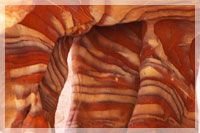 The area encompasses a breathtaking landscape of pink-hued rock mountains, the focus of which is the amazing ancient Nabataean city of Petra, which was carved into the rock more than 2,000 years ago.
The area encompasses a breathtaking landscape of pink-hued rock mountains, the focus of which is the amazing ancient Nabataean city of Petra, which was carved into the rock more than 2,000 years ago.

JORDAN VALLEY
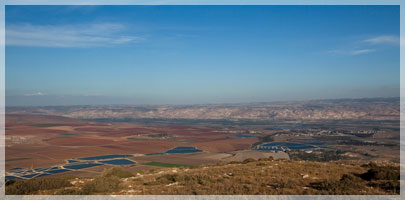 Without a doubt the world's most amazing place, the Jordan Rift Valley is a dramatic, beautiful landscape, which at the Dead Sea, is over 400m (1,312 ft.) below sea level. The lowest point on the face of the earth, this vast stretch of water receives a number of incoming rivers, including the River Jordan.
Without a doubt the world's most amazing place, the Jordan Rift Valley is a dramatic, beautiful landscape, which at the Dead Sea, is over 400m (1,312 ft.) below sea level. The lowest point on the face of the earth, this vast stretch of water receives a number of incoming rivers, including the River Jordan.
Once the waters reach the Dead Sea they are land-locked and have nowhere to go, so they evaporate, leaving behind a dense, rich, cocktail of salts and minerals that supply industry, agriculture and medicine with some of its finest products.
The Dead Sea is flanked by mountains to the east and the rolling hills of Jerusalem to the west, giving it an almost other-worldly beauty. Although sparsely populated and serenely quiet now, the area is believed to have been home to five Biblical cities: Sodom, Gomorrah, Adman, Zebouin and Zoar (Bela).
One of the most spectacular natural and spiritual landscapes in the world, the Jordanian east coast of the Dead Sea has evolved into a major hub of both religious and health & wellness tourism in the region. A series of good roads, excellent hotels with spa and fitness facilities, as well as archaeological and spiritual discoveries make this region as enticing to today's international visitors as it was to kings, emperors, traders, prophets and pilgrims in antiquity.
The leading attraction at the Dead Sea is the warm, soothing, super salty water itself – some ten times saltier than sea water, and rich in chloride salts of magnesium, sodium, potassium, bromine and several others. The unusually warm, incredibly buoyant and mineral-rich waters have attracted visitors since ancient times, including King Herod the Great and the beautiful Egyptian Queen, Cleopatra. All of whom have luxuriated in the Dead Sea's rich, black, stimulating mud and floated effortlessly on their backs while soaking up the water's healthy minerals along with the gently diffused rays of the Jordanian sun.

BETHANY BEYOND THE JORDAN
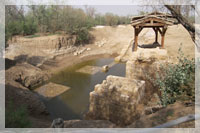 The site of John the Baptist's settlement at Bethany Beyond the Jordan, where Jesus was baptized, has long been known from the Bible (John 1:28 and 10:40) and from the Byzantine and medieval texts.
The site of John the Baptist's settlement at Bethany Beyond the Jordan, where Jesus was baptized, has long been known from the Bible (John 1:28 and 10:40) and from the Byzantine and medieval texts.
The site has now been identified on the east bank of the Jordan River, in the Hashemite Kingdom of Jordan, and is being systematically surveyed, excavated, restored, and prepared to receive pilgrims and visitors. Bethany Beyond the Jordan is located half an hour by car from Amman.
The Bethany area sites formed part of the early Christian pilgrimage route between Jerusalem, the Jordan River, and Mount Nebo.
The area is also associated with the biblical account of how the Prophet Elijah (Mar Elias in Arabic) ascended to heaven in a whirlwind on a chariot of fire.

Madaba
 Madaba and its hinterlands were repeatedly mentioned in the Old Testament. Then it was known as Medeba and it featured in narratives related to Moses and the Exodus, David's war against the Moabites, Isaiah's oracle against Moab and King Mesha of Moab's rebellion against Israel.
Madaba and its hinterlands were repeatedly mentioned in the Old Testament. Then it was known as Medeba and it featured in narratives related to Moses and the Exodus, David's war against the Moabites, Isaiah's oracle against Moab and King Mesha of Moab's rebellion against Israel.
Between the 4th and 7th centuries AD, the prosperous ecclesiastical centre of Madaba produced one of the world's finest collections of Byzantine mosaics, many fine examples of which are well-preserved. Several church floor mosaics can be seen in their original locations, while others have been moved for protection and displayed in the Madaba Archaeological Park.
Madaba's real masterpiece, in the Orthodox Church of St. George, is the 6th century AD mosaic map of Jerusalem and the Holy Land – the earliest religious map of the Holy Land in any form to survive from antiquity.
Madaba is just 86km south of Amman, Madaba has been inhabited for at least 4,500 years, and is mentioned in the Bible as the Moabite town of Medeba (Numbers 21:30). After several centuries of Moabite and Nabataean rule, Medeba and the surrounding lands became part of the Roman Province of Arabia with the Emperor Trajan's conquest of the Nabataean Kingdom in 106 AD.
During the 1st century AD, Christianity spread rapidly through the Roman province of Arabia, but the Romans persecuted believers. Several martyrs died for their beliefs in Madaba, under the orders of Emperor Diocletian. In the 4th century, the emperor Constantine converted to Christianity, which then became the dominant religion of the Roman Empire.
During the Byzantine era from the 5th century onwards, Madaba had its own bishop, and numerous churches were constructed from the 6th to the 7th century. Mosaic floors were the hallmark of this era and continued to be made in Madaba until the 8th century. In 749 AD, a devastating earthquake leveled the city and it was abandoned. In 1897, three Christian families, consisting of a group of 2,000 people, migrated to Madaba from the ancient crusader town of Karak. After that event, the city became predominantly Christian. Numerous mosaics were discovered when new housing and churches were built to provide for the new immigrants.

ST. GEORGE GREEK ORTHODOX CHURCH
 Situated in the centre of the town, St. George's Greek Orthodox Church contains a remarkable mosaic map that portrays the entire ancient Holy Land dating from 560 AD. The map depicts the Phoenician cities of Tyre and Sidon in the north, to Egypt to the south, and from the Mediterranean Sea in the west to the Arabian Desert in the east.
Situated in the centre of the town, St. George's Greek Orthodox Church contains a remarkable mosaic map that portrays the entire ancient Holy Land dating from 560 AD. The map depicts the Phoenician cities of Tyre and Sidon in the north, to Egypt to the south, and from the Mediterranean Sea in the west to the Arabian Desert in the east.
St. George's Church :
The mosaic was discovered in 1897 when a flat area on a hill was chosen on which to build a church.When the area was cleared for construction, a church foundation and a large mosaic was discovered that represented the floor of an ancient Byzantine church built around 560 AD. The original mosaic was an astounding 15.7x5.6m and is at present 15x3m. It displays all the major cities and features in the Holy Land with remarkable accuracy. Jerusalem, and all its major features is the most important city, and is placed in the centre of the map. The Church of the Holy Sepulchre is clearly shown as well as the Cardo Maximus, a colonnaded main street that ran east/west through the centre of the Old City.
Fragments of the Cardo Maximus, built by the Romans after they destroyed Jerusalem in 70 AD, can still be seen in Jerusalem today. There are 157 Greek captions that label most of the important towns and features of the Holy Land at that time. The mosaic also includes the Jordanian towns of Karak and Madaba.

Mount Nebo
 According to the final chapter of Deuteronomy, Mount Nebo is where the Hebrew prophet Moses was given a view of the Promised Land that God was giving to the Hebrews. "And Moses went up from the plains of Moab to Mount Nebo, the top of Pisgah, which is opposite Jericho." (Deuteronomy 34:1).
According to the final chapter of Deuteronomy, Mount Nebo is where the Hebrew prophet Moses was given a view of the Promised Land that God was giving to the Hebrews. "And Moses went up from the plains of Moab to Mount Nebo, the top of Pisgah, which is opposite Jericho." (Deuteronomy 34:1).
According to Jewish and Christian tradition, Moses was buried on this mountain by God himself, and his final resting place is unknown. Scholars continue to dispute whether the mountain currently known as Nebo is the same as the mountain referred to in the Torah.
Islamic belief holds that Musa (Moses) was buried not on the mountain but a few kilometres to the west, somewhere beyond the River Jordan.
On the highest point of the mountain, Syagha, the remains of a church and monastery have been uncovered. The church, discovered in 1933, was constructed in the second half of the 4th century to commemorate the place of Moses' death. The church design follows a typical basilica pattern. It was enlarged in the late 5th century AD and rebuilt in 597 AD. The church is first mentioned in an account of a pilgrimage made by a lady Aetheria in 394 AD.
Six tombs have been found hollowed from the natural rock beneath the mosaic-covered floor of the church. In the present presbytery you can see remnants of mosaic floors from different periods. The earliest of these is a panel with a braided cross presently placed on the east end of the south wall.
On March 19, 2000, Pope John Paul II visited the site during his pilgrimage to the Holy Land (Mount Nebo being one of the most important Christian sites in Jordan). During his visit he planted an olive tree beside the Byzantine chapel as a symbol of peace.
In addition to Mount Nebo, there are four other holy sites that were designated by the Vatican as Millennium 2000 pilgrimage sites.
The Serpentine Cross sculpture (the Brazen Serpent Monument) atop Mount Nebo was created by Italian artist, Giovanni Fantoni. It is symbolic of the bronze serpent created by Moses in the wilderness (Numbers 21:4-9) and the cross upon which Jesus was crucified (John 3:14).

UMM AR-RASAS
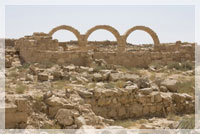 A rectangular walled city, about 30km south-east of Madaba, which is mentioned in both the Old and New Testaments of the Bible. It was fortified by the Romans, and local Christians were still embellishing it with Byzantine-style mosaics well over 100 years after the start of the Muslim Umayyad rule.
A rectangular walled city, about 30km south-east of Madaba, which is mentioned in both the Old and New Testaments of the Bible. It was fortified by the Romans, and local Christians were still embellishing it with Byzantine-style mosaics well over 100 years after the start of the Muslim Umayyad rule.
Most of the city now lies in ruins, but there are several buildings in its eastern part, including churches, a courtyard with a well, staircases and stone arches that have all been excavated and restored. More recent excavations have revealed some of the finest Byzantine church mosaics in the Middle East.
Just outside the city walls is the recently unearthed Church of St. Stephen with its perfectly-preserved, outstanding mosaic floor, the largest of its kind to be discovered in Jordan, and second only to the world famous mosaic map at Madaba. The mosaic depicts the images of 27 Old and New Testament cities of the Holy Land, east and west of the River Jordan.
Just two kilometres north of Umm Ar-Rasas is the highest standing ancient tower in Jordan, believed to have been used as a place of solitude by early Christian monks. The tower is 15m high and has no door or inner staircase. Today it is inhabited only by flocks of birds.

DHIBAN
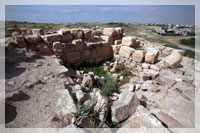 Known during Biblical times as Dibon, it was the capital of ancient Moab. It is located about 30km to the south of Madaba, just before the spectacular descent into Wadi Mujib - aptly dubbed as Jordan's Grand Canyon.
Known during Biblical times as Dibon, it was the capital of ancient Moab. It is located about 30km to the south of Madaba, just before the spectacular descent into Wadi Mujib - aptly dubbed as Jordan's Grand Canyon.
The site comprises two hills: The southern hill which is now occupied by the modern town, and the northern hill, which was excavated in the 1950s and 1960s. Excavations indicate that this site was occupied in the Early Bronze Age (c.3000 BC), with no evidence that it was occupied in the Middle and Late Bronze Ages (c.1950-1250 BC).
According to the Biblical account, Dibon was captured from the Moabites by Sihon, King of the Amorites (Numbers 21: 21-30), who in turn was overthrown by the Israelites. Omri, King of Israel, subdued Moab and his heirs, until Mesha, the king of Moab who was residing in Dibon, revolted and extended his kingdom northwards as far as Nebo. To celebrate his victory, Mesha built a new royal quarter, which he called Qarhoh (the prominent). It included a highplace for the Moabite god Kemosh, a palace, an acropolis with gates and towers, and houses for his people. He also set up a stela recounting his achievements. The basalt stone stela was discovered in 1868 and now graces the Louvre Museum in Paris. It is the longest known Moabite inscription. The Bible describes King Mesha as a sheep-breeder who "had to deliver annually to the King of Israel a hundred thousand lambs, and the wool of a hundred thousand rams" (2 Kings 3:4). This together with the story of Ruth (Ruth 1: 1-5) attests to Moab's agricultural productivity.
In 731 BC, Moab was under Assyrian domination. Later, Moab joined a general revolt against the Babylonian king, Nebuchadnezzar, which led to the state's destruction in 582 BC, five years after the sack of Jerusalem.
For about five centuries the site was deserted. Prosperity returned to Dibon under the Nabataeans, who built a fine temple at the southeastern quadrant of the hill. Also, the walls on the summit of the site were rebuilt as was a north gate. Two inscriptions and the remains of a bath indicate there was a Roman garrison here in the 3rd century. Architectural features from the Byzantine and subsequent Umayyad periods include the remains of a 6th century church and two small domed structures. In the 19th century, the village relocated to the south hill using the ancient tall as a burial ground.

AQABA
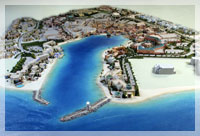 With its wealth of other attractions, Jordan's splendid Red Sea resort is often overlooked by modern-day visitors. But apart from being a delightful place for discerning holidaymakers, this is actually a great base from which to explore various places of interest in southern Jordan.
With its wealth of other attractions, Jordan's splendid Red Sea resort is often overlooked by modern-day visitors. But apart from being a delightful place for discerning holidaymakers, this is actually a great base from which to explore various places of interest in southern Jordan.
Aqaba is a fun place. It is a microcosm of all the good things Jordan has to offer, including a fascinating history with some outstanding sites, excellent hotels and activities, superb visitor facilities, good shopping, and welcoming, friendly people, who enjoy nothing more than making sure their visitors have a good time.
But perhaps Aqaba's greatest asset is the Red Sea itself. Here you can experience some of the best snorkelling and diving in the world. The temperate climate and gentle water currents have created a perfect environment for the growth of corals and a teeming plethora of marine life. Here you can swim with friendly sea turtles and dolphins as they dart amongst the schools of multi-coloured fish. Night dives reveal the nocturnal sea creatures, crabs, lobsters and shrimp, as they search for a midnight snack.
There are several dive centres in Aqaba. All offer well-maintained diving equipment, professional instructors, and transport by boat to a variety of dive sites.
For those who prefer to keep their feet dry, all the deep sea wonders can be viewed through a glass-bottomed boat or by submarine, or you can just relax under the sun on the resort's sandy beaches. Plus, of course, there are plenty of other water-sport activities available, as well as an extensive and interesting Marine Park.
From as far back as five and a half thousand years ago Aqaba has played an important role in the economy of the region. It was a prime junction for land and sea routes from Asia, Africa and Europe, a role it still plays today. Because of this vital function, there are many historic sites to be explored within the area, including what is believed to be the oldest purpose-built church in the world.
Aqaba International Airport is situated just 20 minutes from the town centre and services regular flights from Amman as well as from several European cities. From the town centre, the borders of Israel, Egypt's Sinai and Saudi Arabia are no more than a 30-minute drive.

TALL MAR ELIAS
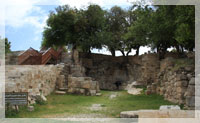 Associated with the Prophet Elijah, Tall Mar Elias is very close to the ruins of a village known as Listib. It is believed that this place was formerly Tishbi, the home of Elijah, a native of Gilias in Tranjordan (2 Kings 17: I). The fact that this is a religious site is substantiated by the two churches that were built on the Tall (hilltop) at the end of the Byzantine period.
Associated with the Prophet Elijah, Tall Mar Elias is very close to the ruins of a village known as Listib. It is believed that this place was formerly Tishbi, the home of Elijah, a native of Gilias in Tranjordan (2 Kings 17: I). The fact that this is a religious site is substantiated by the two churches that were built on the Tall (hilltop) at the end of the Byzantine period.
Elijah is known as the prophet Elias in Arabic. The Koran calls him "an honorable man" and a "messenger of God". It also says "we left mention of him among later men", which refers to Elijah's association with Moses, John the Baptist and Jesus.
The site at Tall Mar Elias includes extensive architectural remains that are scattered across the summit of the hill that rises above Listib, from the southeast.

ANJARA
 It is believed that Jesus Christ, his disciples, and the Virgin Mary, passed through Anjara once and rested in a cave there during a journey between the Sea of Galilee, the Decapolis cities, Bethany Beyond the Jordan and Jerusalem.
It is believed that Jesus Christ, his disciples, and the Virgin Mary, passed through Anjara once and rested in a cave there during a journey between the Sea of Galilee, the Decapolis cities, Bethany Beyond the Jordan and Jerusalem.
The cave in Anjara has long been a holy place for pilgrims and has now been commemorated with a modern shrine, the Church of Our Lady of the Mountain. The cave was also designated by the Catholic Churches of the Middle East as one of the five pilgrimage sites for the year 2000.

KHIRBAT AL-WAHADINA
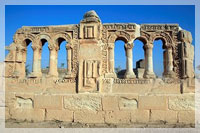 Pilgrimage to the birthplace of St Elijah
Pilgrimage to the birthplace of St Elijah

MUKAWIR
 The 1st century AD Roman-Jewish historian, Josephus, identifies the awe-inspiring site of Mukawir (Machaerus) as the palace/fort of Herod, who was the Roman-appointed ruler over the region during the life of Jesus Christ.
The 1st century AD Roman-Jewish historian, Josephus, identifies the awe-inspiring site of Mukawir (Machaerus) as the palace/fort of Herod, who was the Roman-appointed ruler over the region during the life of Jesus Christ.
It was here, at this hilltop fortified palace, overlooking the Dead Sea region and the distance hills of Palestine and Israel that Herod Antipas, the son of Herod, imprisoned and beheaded John the Baptist after Salome's fateful dance.

THE DEAD SEA & LOT'S CAVE
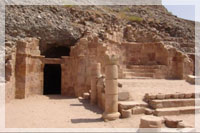 The Dead Sea is one of the most dramatic places on earth, with its stunning natural environment equally matched by its powerful spiritual symbolism.
The Dead Sea is one of the most dramatic places on earth, with its stunning natural environment equally matched by its powerful spiritual symbolism.
The infamous Sodom and Gomorrah and other cities of the Dead Sea plain, or (Cities of the Valley) were the subjects of some of the most dramatic and enduring Old Testament stories, including that of Lot, whose wife was turned into a pillar of salt for disobeying God's will. Lot and his two daughters survived and fled to a cave near the small town of Zoar (modern-day Safi). The Bible says Lot's daughters gave birth to sons whose descendents would become the Ammonite and Moabite people, whose kingdoms were in what is now central Jordan. Although not confirmed, the sites of the cities of Sodom and Gomorrah are believed to be the remains of the ancient walled towns of Bab ed-Dhra' and Numeira, in the southeastern Dead Sea central plain. On a hillside above the town of Zoar (modern-day Safi), Byzantine Christians built a church and monastery dedicated to Saint Lot. The complex was built around the cave where Lot and his daughters found refuge.

AS-SALT
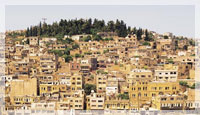 The City of As-Salt, northwest of Jordan's capital, Amman, houses the tomb/shrine of Job, the wealthy, righteous man from the Land of Uz.
The City of As-Salt, northwest of Jordan's capital, Amman, houses the tomb/shrine of Job, the wealthy, righteous man from the Land of Uz.
As-Salt is also the location of the tomb/shrine of the prophet Jethro, who was the father-in-law of Moses. It is also the site of the tombs of Jad and Asher, who were both sons of Jacob.

PELLA
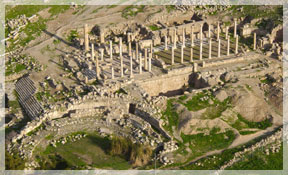 Some of the most important events in the lives of Isaac's twin sons, Jacob and Esau, took place in ancient Jordan.
Some of the most important events in the lives of Isaac's twin sons, Jacob and Esau, took place in ancient Jordan.
Modern day Pella (ancient 'Penuel', meaning 'the face of God') was so named by Jacob after he wrestled there all night with God in the form of a man or angel (Genesis 32:24-30). A massive Bronze and Iron Age temple recently discovered at Pella, in the northern Jordan Valley, is thought to be the best-preserved temple from Old Testament times anywhere in the Holy Land

THE KINGS' HIGHWAY
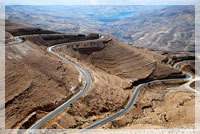 The Kings' Highway is the world's oldest continuously used communication route. It linked ancient Bashan, Giliad and Ammon in the north with Moab, Edom, Paran and Midian in the south.
The Kings' Highway is the world's oldest continuously used communication route. It linked ancient Bashan, Giliad and Ammon in the north with Moab, Edom, Paran and Midian in the south.
Abraham - a common patriarch of Jews, Christians, and Muslims - who passed through northern, central and southern Jordan, would certainly have used this route on his journey from Mesopotamia to Canaan.
Moses asked the King of Edom if he and his people could "go along the Kings' Highway" during their journey to Canaan, but his request was refused. The Kings Highway is also mentioned in an earlier story in Genesis 14:5-8, in relation to the four Kings from the north, who attacked Soddom and Gomorrah and the three other Cities of the Plain.
